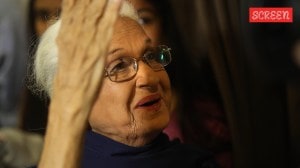Stay updated with the latest - Click here to follow us on Instagram
Labourer,farmer… expert fossil hunters
In 1973 when he was all of 10,Kaka Singh of Siswan village near Chandigarh started hunting for fossils in pockets of Shivaliks,the foothills of Himalayas.
Forest dept plans to use treasure trove that dates back to 2.6 million years to promote eco-tourism in villages on Punjab-Himachal border near Chandigarh
In 1973 when he was all of 10,Kaka Singh of Siswan village near Chandigarh started hunting for fossils in pockets of Shivaliks,the foothills of Himalayas. A student from Chandigarh used to come to our village to collect these stones. I was fascinated by his activity and would accompany him to the forests. He used to pay me Rs 5 per visit, he says. After a few years the student stopped coming to the village but fossils had caught fancy of Kaka,who is now a lanky man of 48 years and continues to comb forests in Siswan and Mirzapur villages of Punjab on the border of Himachal Pradesh,barely a few kilometers from Chandigarh. About three years ago,when senior forest officers saw the collection of Kaka,who is a daily-wager,they decided to use these to promote eco-tourism project in the villages. He is one of the two fossil hunters whose collections will be showcased by the Punjab Forest Department.
Kaka calls fossils stones. I have been collecting these stones for years and always knew in my heart that these were valuable. I knew that one day someone will come and give me a pat on my back for my jungle explorations, he says with a toothy smile.
He has given the 25 fossils that he has hunted so far to the Forest Department but a couple of them are kept in his safe custody. Showing one of his object dart,an unlettered Kaka says,This is part of jaw of a rakshas (demon). I found it 5 feet below while digging for the foundation of my house. An officer in the Forest Department says this fossil may be of a dinosaurs,though it has not been tested so far.
Possessive of his discoveries,Kaka says,Sometime ago,a person made persistent bids for the rakshas jaw and he was ready to pay a tidy sum for it. But I refused. And since then I have kept it safely. With an eagle eye for fossils,he goes to the forests at 6 am every day. Due to heavy soil erosion caused by denuding of Shivaliks,such stones sometimes fall to the forests in Punjab in THE rainy season. My 20-year-old son who works as a welder also help me in the job, he says.
In nearby Mirzapur village lives a fifty-something farmer,Dela Ram,who doesnt remember since when he has been collecting fossils. He says the village is a treasure trove of such remains waiting to be discovered. You pick up any stone in this village,and it has history engraved on it, he says pointing to a temple. All the statues in this Shiv temple were not brought from anywhere but excavated from the village, Dela Ram claims.
Though he ploughs his nine acres to eke out a living,forest exploration has been his favourite pastime. Three to four years ago,a team of forest officers and a geologist from Panjab University visited the village,and were surprised to see the finds of Dela Ram.
However unlike Kaka,Dela Ram is not ready to part with his fossils,which he has tucked away on the roof of his house. They are my property. I can give them only for exhibitions, he says.
Chief Conservator of Forests (Hills) Jitendra Sharma,who had led the team to meet these villagers,says they had requested Dr Avinash Chandra Nanda,retired scientist-G of Wadia Institute of Himalayan Geology,Dehradun,to study the fossils,and he had prepared a report for them. Dela Ram,who also has a copy of the document prepared by Dr Nanda,says,I keep this paper safely,for it is a cogent evidence that my discoveries are a treasure. Earlier,fellow villages would poke fun at me,saying,ki pathar chake firda hai (he wanders with stones). I had even thrown away some of the fossils on being ridiculed.
But now villagers respect me, he adds,while showing a photograph in which he is shaking hands with American experts who had come to an exhibition organised by the Forest Department,where his fossils were also exhibited. The report says that the fossil of a camel is 3 million years old; jaw of a cow 5 million years old; an antelope horn 2.5 million years old and a cow horn 2.5 million years old. Though the region is not known to have rhinoceros,a 2.5-million-year-old jaw of the animal also finds mention in the document.
But Dela Ram has a grouse. He says the Forest Department had a few years ago raised his hopes by promising to start the eco-tourism project,and set up a devoted stall for fossils but nothing has happened on ground. Assuring that they will soon start work on the project,Chief Conservator Jitendra Sharma says it will be a community-driven tourism undertaking. Because of the dam that has come up in the area,the villages downstream have been benefited but residents of Siswan and Mirzapur continue to suffer. So we wanted to start a pilot project for augmenting their livelihood. We took a multi-disciplinary team to the area and discovered its precious heritage,which will be preserved, he says. Sharma says Kaka Singh is a very good resource person for the department. A motivated collector,he is a natural history observator who has contributed 70 per cent of the fossils to the department. Both of them know the forest like the back of their hands and we want to tap this local knowledge pool. We have also apprised them of the heritage value of their finds, he adds. Asserting that he had studied the fossils sent by the Forest Department,geologist Dr Nanda says certain pockets of Shivaliks in Punjab are rich in such remains,which are mainly 3.2 million years old. These are not uniformly distributed and the best finds can be expected in the belt between Ropar and Chandimandir,and stretching from there up to Kala Amb in Himachal on the other side. The Jammu region is the second best, he adds. Underlining the need for sensitising villagers about the importance of fossils,Dr Nanda says,Locals are in a bad habit of selling them. The government should create awareness. We cannot train them to find the age of a fossil which is the work of a geologist but they should be told to inform the experts about the locations from where they have collected them.







